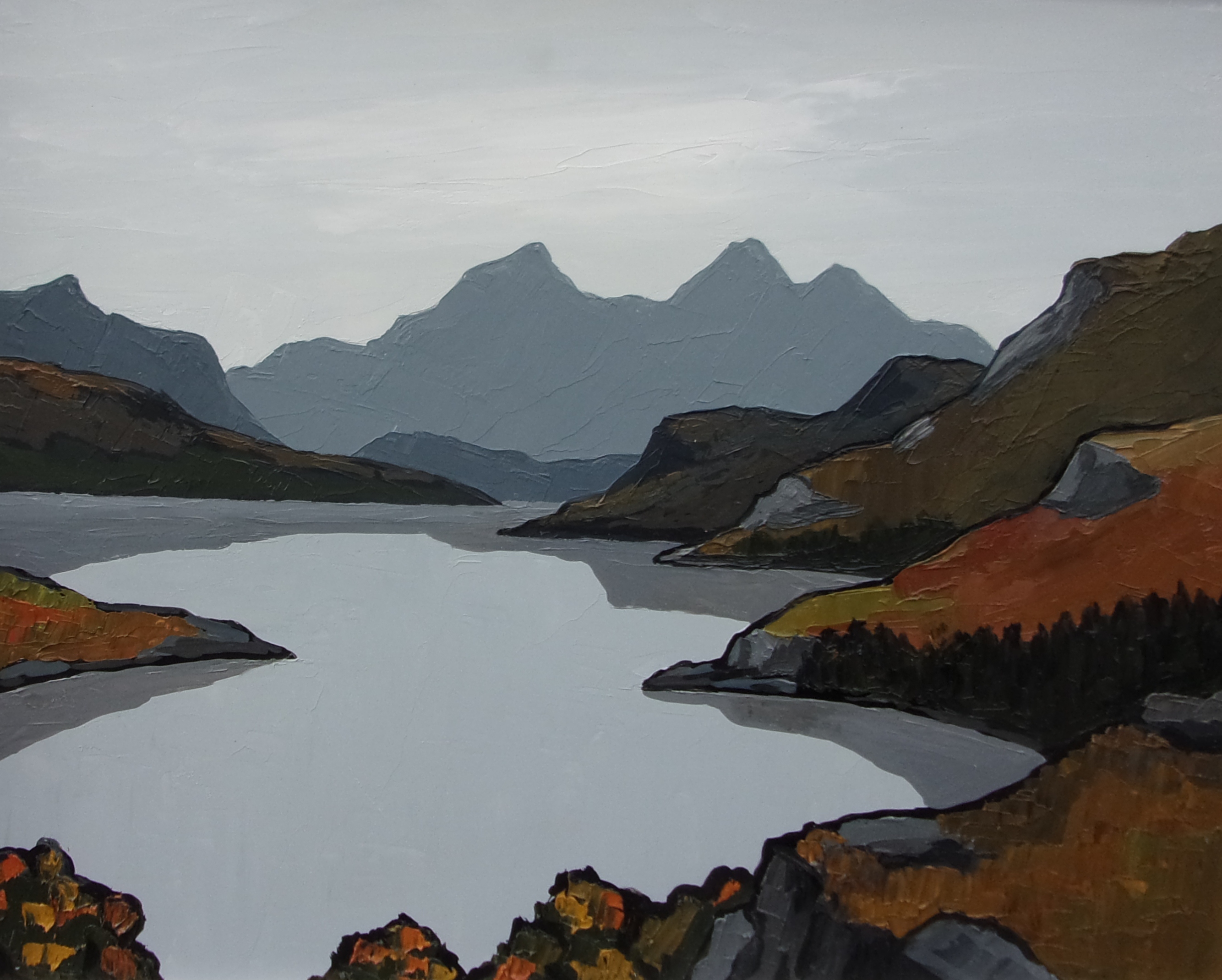LATEST NEWS
British landscape paintings and drawings by renowned artist David Tress
Widely regarded as one of Britain’s most inventive landscape painters David Tress has been a regular exhibitor at the Albany Gallery for over 40 years. This exhibition features a collection of expressionist landscape paintings and drawings of the British Isles – including his beloved Pembrokeshire, where he made his home almost 50 years ago.
', mixed media on paper, 33x47cm, 2018.jpg)
London-born David has lived in West Wales since 1976, and the landscape of this part of Britain forms the subject of many of his paintings but it’s Pembrokeshire that is a constant source of inspiration. Patterns of small fields and hedge banks, the coast and the rocky uplands of North Pembrokeshire have always been a core subject for him.
The geographical spread of this show includes paintings of Teesdale in the North East, the landscape of Bodmin Moor in the far South West and, in contrast to these wilder landscapes, a study of Stourhead in Wiltshire. David has always been a regular visitor to the English landscape gardens at Stourhead and continues to be fascinated by the placing of eighteenth neo-classical buildings in this carefully composed and contrived layout of land, trees and water.
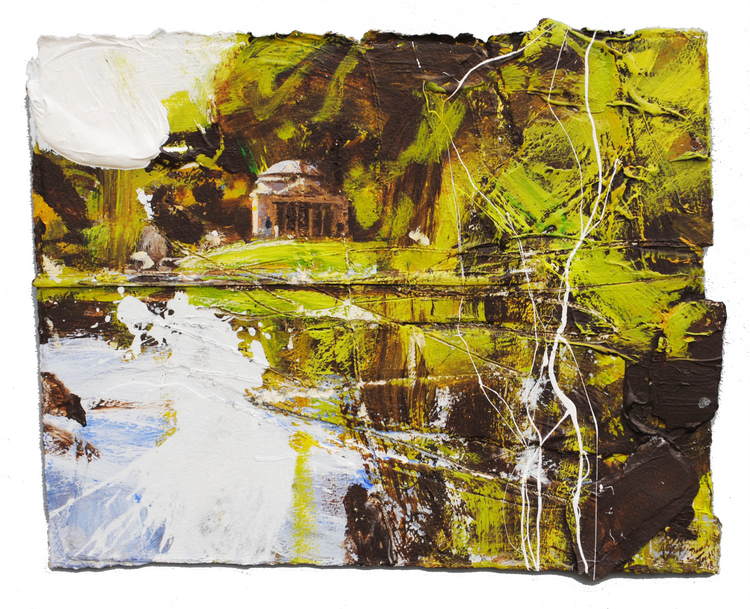
He has also been a regular visitor over many years to the west of Scotland and the continually changing light and weather of the mountainous coastal areas around Torridon and the Western Isles have been a constant source of fascination.
He says: “Part of the excitement of drawing in these landscapes is the uncertainty of what will be encountered: a sunlit day can be unexpectedly interrupted by sharp showers, and it is not uncommon for an unpromising morning of low cloud and rain to be disturbed by a stiffening breeze and break up to show the most breathtaking spectacle of brilliant patches of sun lighting up mountainsides in deep shadow.
“The paintings that I later make in the studio from drawings made on the spot are certainly to do with the contrasts of shapes, tonal drama and colour in these landscapes, but are also very much concerned to express the delight, excitement or even physical power of being part of these landscape environments.
“Making a drawing in a sketchbook may well involve a battle with wind tearing at sketchbook pages, and drops of rain quickly converting them into papier mâché. In these conditions full waterproofs are a great help – though, even then, after half an hour or so the rain always seems to manage to find its way through hats and anoraks.”
', mixed media on paper, 57x73cm, 2016.jpg)
David, who was one of 48 British artists and designers commissioned by the Royal Mail to design the Millennium special issue of stamps in 1999, adds that the Pembrokeshire landscapes which make up most of this exhibition are perhaps more contemplative than the raw vigour of the Scottish subjects.
“These are landscapes that I have visited on countless occasions, and when I am out drawing at locations north of Haverfordwest or between St. David’s and Fishguard I can hardly begin work in my sketchbook without conjuring up a multitude of images and memories of previous visits to these areas.
“Indeed, the paintings that I make are as much to do with memory as they are to do with what is seen at any particular time. Having made drawings on the spot the paintings will be slowly worked on in the studio – I almost always leave a painting that I am working on for a few days or a week or two, and come back to it to build and rework it.
“This means that the resulting images (if they survive and are not destroyed as a failure) develop heavy encrustations of texture from paint and collaged paper. It is within this process of making and remaking that – with luck – something almost unexpected will emerge as a final image.”
David Tress exhibits at Albany Gallery from 5 April - 27 April.
David Tress is represented internationally by David Messum Fine Art.
Judith Bridgland and Gerald Green. Stunning oil paintings inspired by their travels and favourite places.
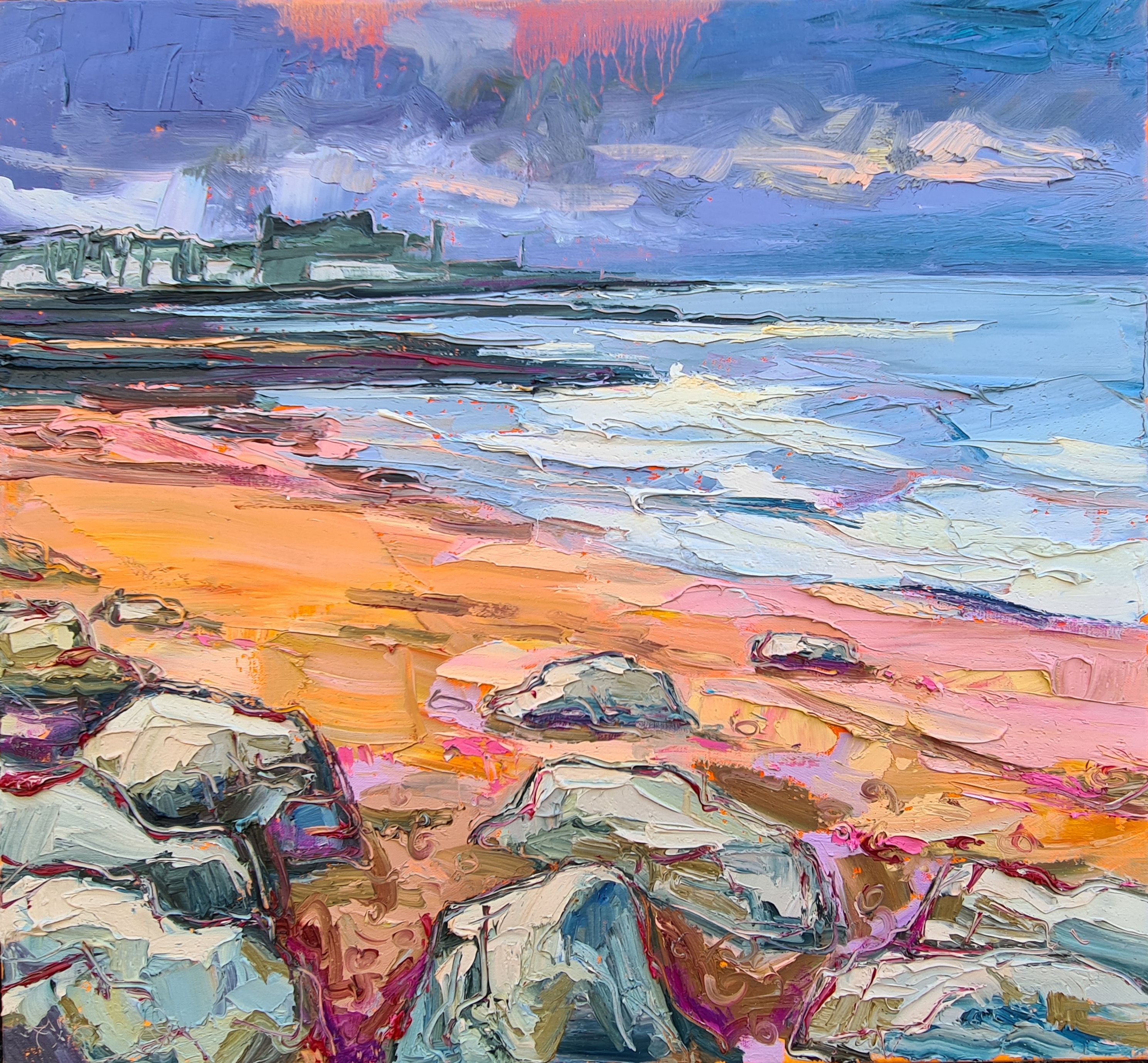
Judith Bridgland was born in Australia, and trained in Glasgow, Scotland where she lives and works.
Working in oils, her paintings use bold, vigorous, rhythmical strokes of impasto paint combined with delicate brushwork and she says Wales is one of her top destinations to visit.
“Wales is a favourite place to find inspirational landscapes, and the wonderful Gower reminds me so much of the rugged west coast of Scotland, where I am based. It’s a long journey but I am especially fond of the little village of Port Eynon,” she says. “I’ve been returning there for a number of years now, with the long curve of the bay and the colours and sand patterns that constantly change throughout the day. The dunes and coastal paths are covered in the most wonderful wildflowers, so different throughout the seasons.
“I also love the sweeping coastline of Rhossili, because you can see such a very long way into the distance – it’s exhilarating! The bay of sand is so vast, it’s difficult to tell how big it really is. You can sit on the cliff there, and watch the clouds and weather roll in, the shadows chasing across the strand and up the cliffs. The mood of the landscape changes in a moment.
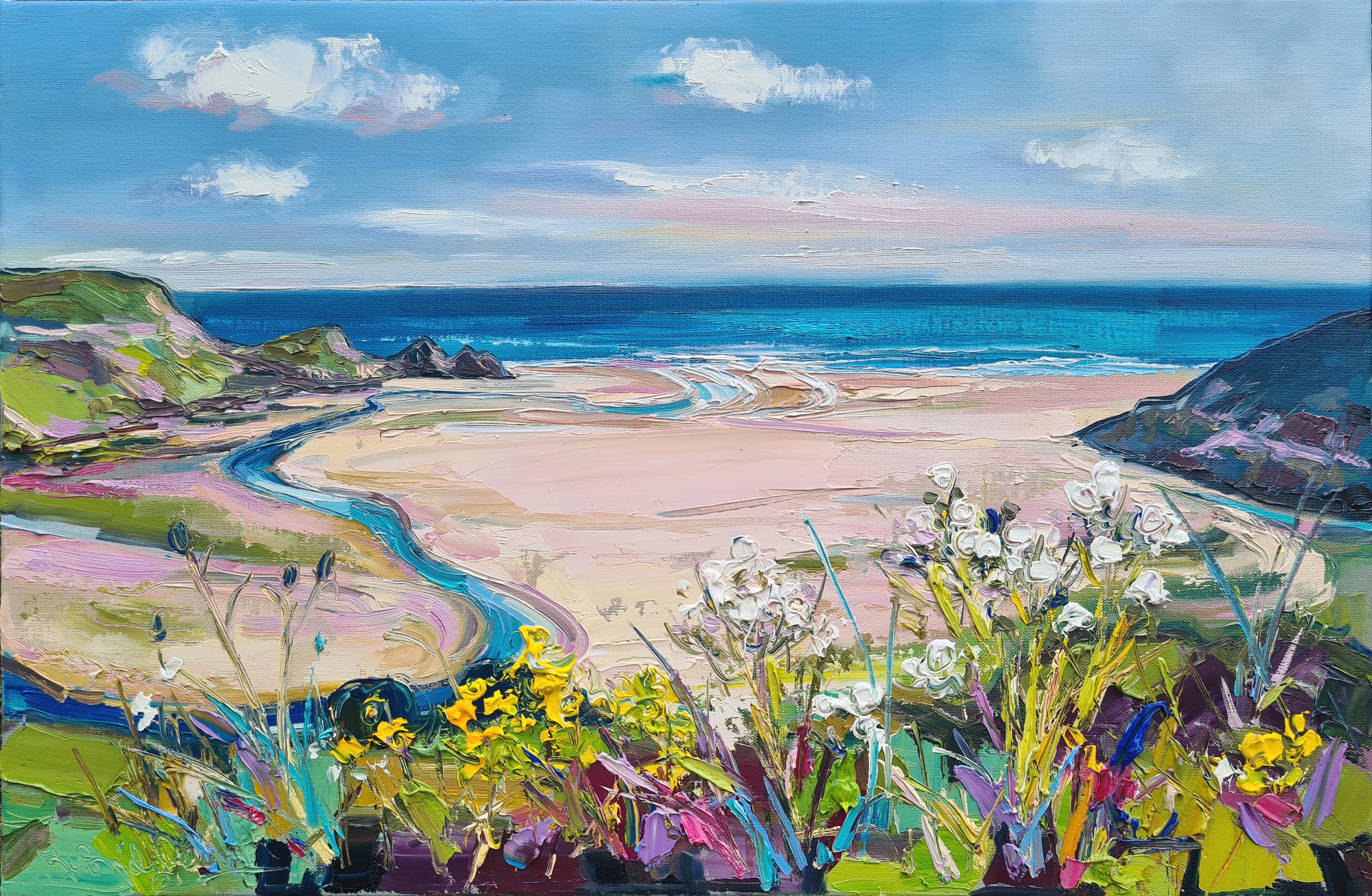
She added: “Another favourite place is Three Cliffs Bay, again because you can get such a fantastic all-around view on the clifftop of the dramatic coastline there. There is also the beautiful, serpentine curve of the river flowing across the sand, and the mood of the place can change so quickly depending on the weather and the season. Every time, it looks different.”
Judith takes many photographs during her visits and then, back in the studio, uses the tactile, textural qualities of oils to build up the paintings in an almost sculptural way. Lots of impasto mark-making, using palette knives and a wide range of brushes, build the sense of energy and vitality of the landscape.
In 1986 British artist Gerald Green, who is based in Warwickshire, gave up his career as an architect to follow his passion for painting. His work has been shown in Europe, USA and in 2010 he was an invited artist for the inaugural International Watercolour Biennial in China.
He too takes inspiration from places he has visited and creates paintings which are his own interpretations of places and everyday events.
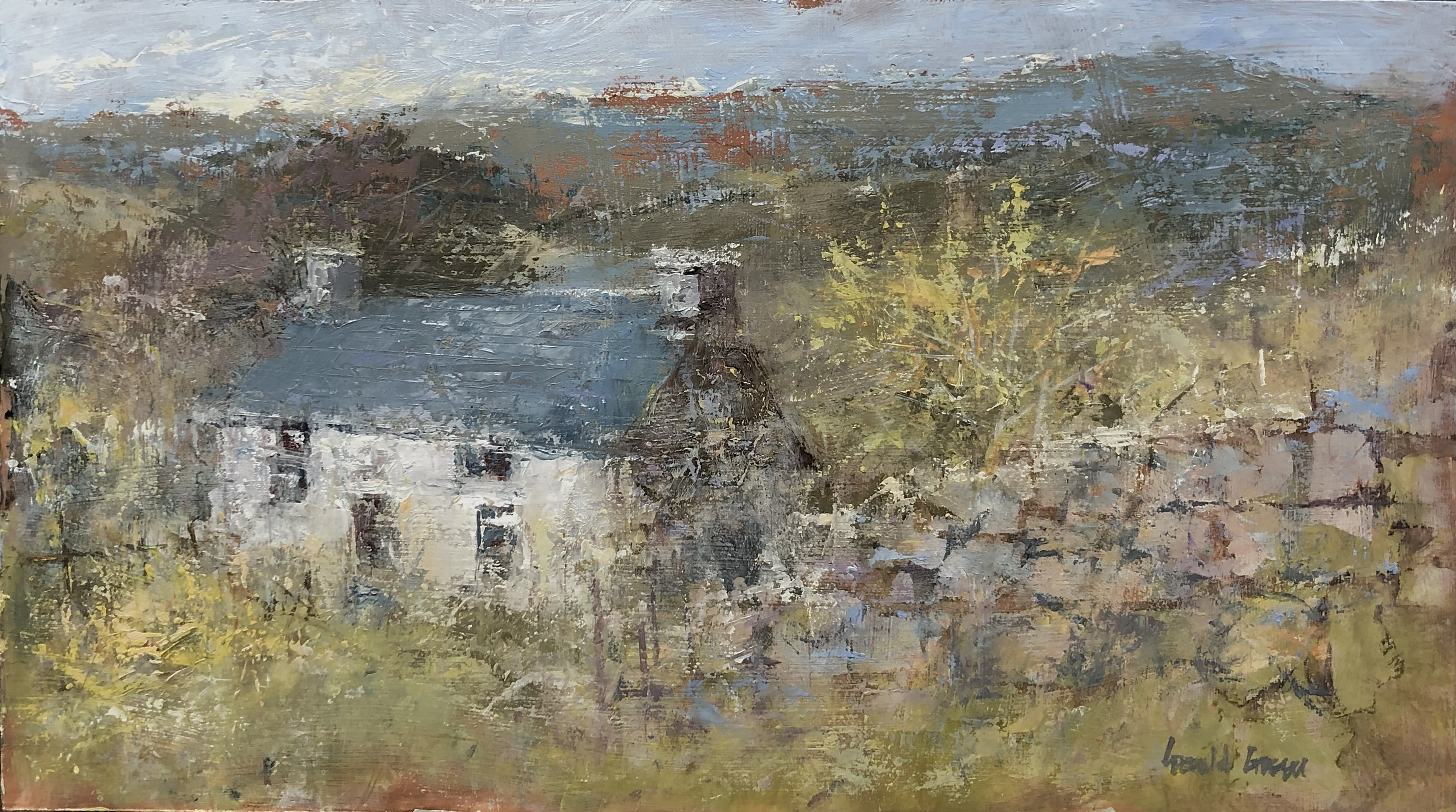
Gerald, who is also a published author and contributor to arts magazines, regularly paints ‘en plein air’ and says his paintings are personal responses to what he sees. His approach is to interpret the essence of subjects with an artistic portrayal that depicts them as anything but ordinary. Light is the essential ingredient that he uses to energise and invigorate his work.
This collection includes stunning images of Sorrento’s Grand Harbour, a pretty Powys cottage, a greenhouse scene, a piano and many more.
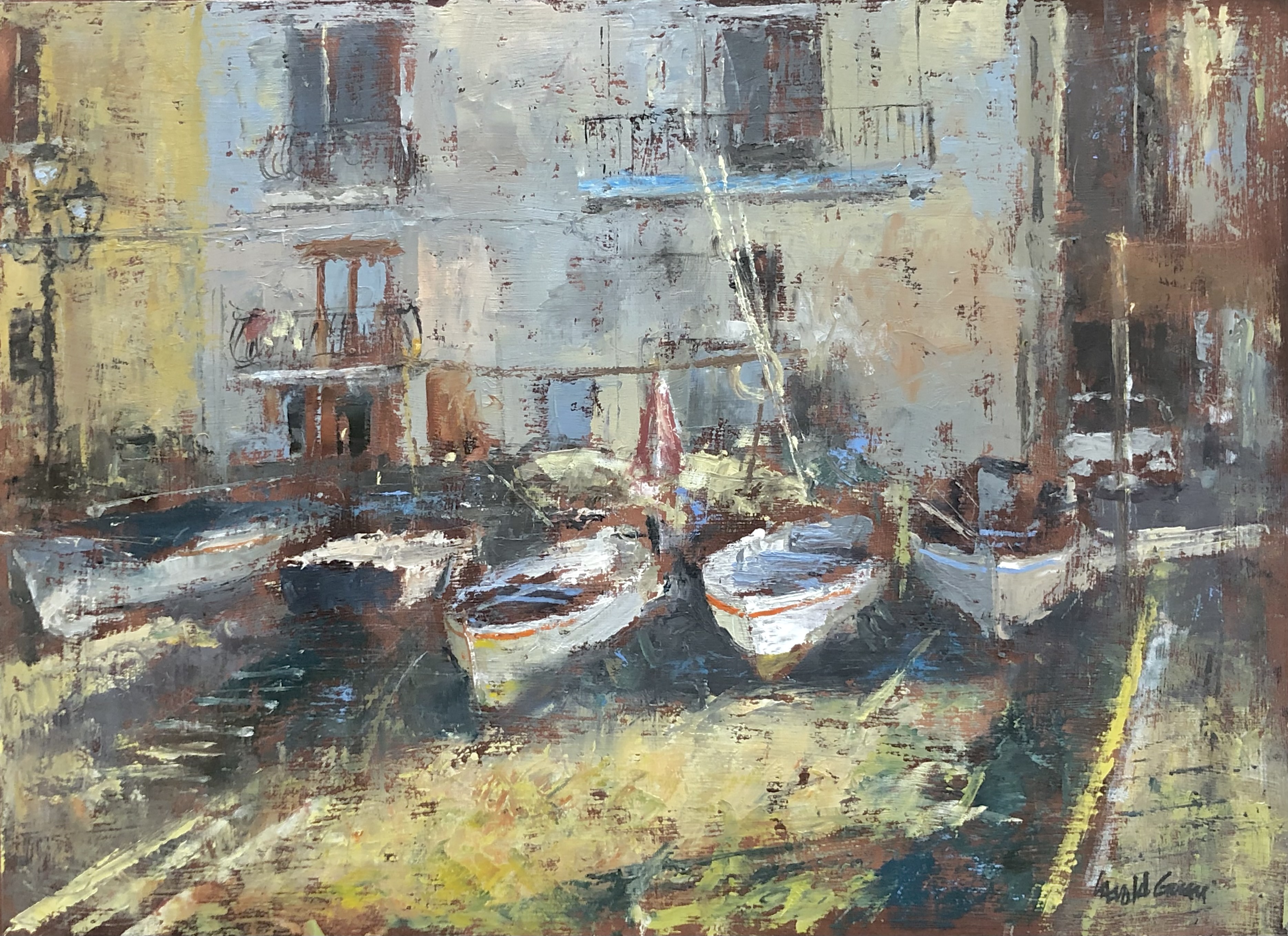
He says: “My paintings are impressions of places and events from everyday life. Many are painted on the spot with a sense of what I like to call 'casual reality' through which I aim to catch the essence of my subjects with the use of light to energize and invigorate the work.
“The collection of 20 oil paintings I am showing in the exhibition depict an eclectic mix of subject matter, things I have come across on my travels, including vernacular rural Welsh cottages and interiors together with other ancillary subjects in a range of sizes.”
Judith Bridgland/ Gerald Green is at Albany Gallery from 8th - 30th March. View the complete exhibition here.
Bringing together five artists in a show celebrating Varied Visions.
Visitors to the gallery will be treated to a wide selection of paintings from Emma Connolly, David Knight, Lara Smith, Henry Walsh and Paul Weston with stunning scenes from the Monmouthshire canal and Cardiff Castle to the Cornish coast and Venice as well as paintings of beautiful vases, glassware and jugs.
View the complete exhibition here.
Irish artist Emma Connolly is a multi-award-winning Master of Fine Art with more than 20 years’ experience as a professional, with work exhibited internationally in some of the world’s most prestigious galleries and museums.

She believes that art has the power to inspire, to move, and to transform, and is always committed to continuing her exploration of the possibilities of visual expression.
She says: “As an artist, my work is a reflection of my deep connection to the natural world and my ongoing exploration of the interplay between light, texture, and colour. My art is a celebration of the beauty and complexity of the world around us, and I am constantly inspired by the textures and patterns that I find in the natural landscape.
“Whether I am working with oils or mixed media, my goal is always to capture the essence of a particular moment in time, to create a window into the unique beauty of a place or a particular experience.”
David Knight was born in Essex in 1965 but has spent most of his life in Wales and currently lives in Cardiff. He studied Fine Art at the University of Wales Institute Cardiff and graduated with a BA in 1996.
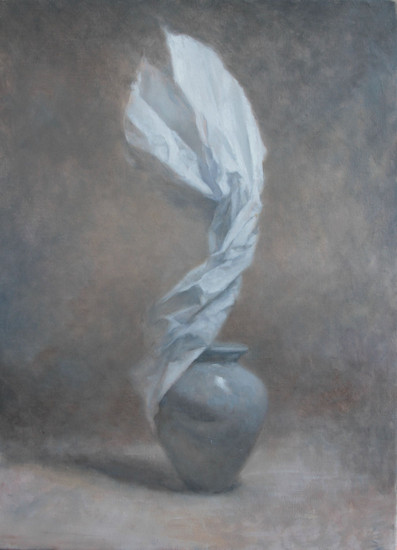
He has produced a selection of wonderful paintings, all oil on canvas, for the exhibition but he admits he finds it hard to determine where he gets his inspiration from.
“It's difficult to say what inspires me to paint. I think artists like Rembrandt, Chardin, Pieter Claesz or Arthur Rackham to name a few are always on my mind when painting,” he says. “Sometimes I want to mix the traditional genre with fairy tale or legend. The jinn paintings for instance are a mixture of these inspirations. I like to tell a story with the figure work. I’m not always sure what that story is but hopefully this work will tell its own tale.”
Lara Smith is a predominantly self-taught artist based in Cardiff. She works mainly in oil with a palette knife, and her artwork aims to capture the atmosphere of her subject with bold strokes.
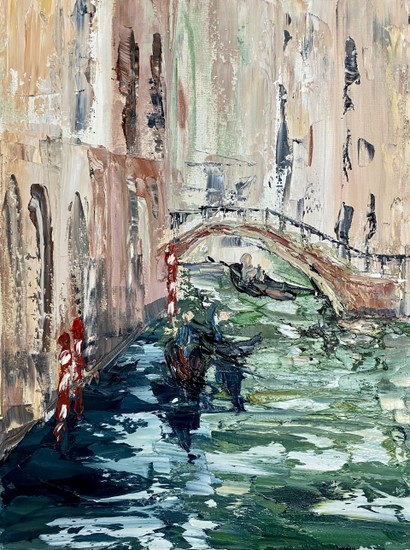
She says: "I have been painting for as long as I can remember. I would describe my work as bold and expressive. I love to use a lot of vibrant colours and my painting style is quite impulsive with strong palette knife strokes. My work in this exhibition features landscapes from some of my favourite places; the Welsh and Cornish coast and Venice, along with a couple of pieces that have come from my own imagination."
Henry Walsh’s paintings, which are works of oil pastel on paper, are so much more than every day scenes in every day life. Beyond the people walking their dogs or sitting on a bench are stories that we can only begin to imagine – and this is what drives Henry, who is from Norwich but who now lives in Derbyshire, to create such captivating scenes.

He says: “I have a wandering empathy for the imaginary lives of strangers. By that I’m talking about when we people-watch (and we all do it), we are creating stories in our head about who that person is and why they are there, where are they going etc. But we can’t actually know these people, we imagine their lives based on our own experiences and the people we’ve met throughout our own path.
“I, and by extension, my work is fascinated by the endless and varied stories we can see in every street, park bench, trip to the beach or dog walk. Crowds and congregations, a myriad of fascinating stories.”
Paul Weston, from Cwmbran, is also a self-taught artist and has created paintings in both water and oil of familiar cities and landscapes. He prefers compact, enclosed compositions rather than more expansive views. At the coast, for example, he will frequently turn his back on the sea to paint a beach café, a cluster of beach huts or an interesting rock formation.
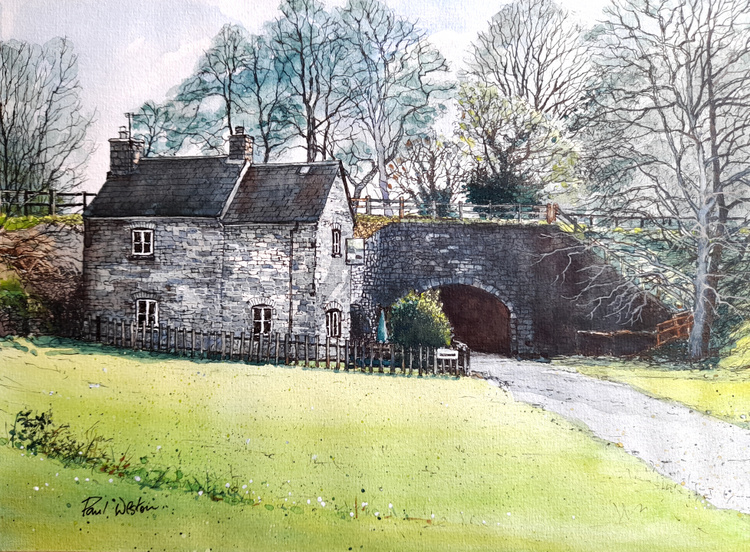
He says: “In this collection for Varied Visions, I have drawn heavily on Cardiff and the Monmouthshire & Brecon Canal for inspiration. With this collection of paintings, I hope to show the different methods and media I use - demonstrating the process and progression from initial ink drawings through to finished watercolours and oil paintings.”
Varied Visions - a group show of five artists featuring Emma Connolly, David Knight, Lara Smith, Henry Walsh, Paul Weston runs from 9 February - 2 March 2024.
Stock room sale, up to 50% off selected works
In order to make space for all the exciting work we have coming into the gallery for the 2024 exhibitions, we are holding a sale of selected work from our stockroom. Artists featured include Faye Anderson, Caroline Bailey, Peter Brown, Alastair Elkes-Jones, Andrew Hood, Sally Muir, Penelope Timmis and many more.

Should you wish to make a purchase or have an enquiry, please call
029 2078 9171 or email info@albanygallery.com. Delivery options are available on request.
Our opening hours are:
Monday - Saturday 10am-5pm
Sunday 11am-4pm
With best wishes and a very Happy New Year from The Albany Gallery team.
COUNTDOWN TO CHRISTMAS
It won't be long before Christmas is upon us and to celebrate we will be counting down the days by offering our followers 10% discount on selected paintings from our Winter Show.
From 1st -23rd December we will be releasing a discounted painting every day at 6pm on Facebook and Instagram. Purchases will be on a first come, first served basis. Each painting will only be available at the lower price until 4pm the following day.
Should you wish to make a purchase, please call 029 2078 9171 or email info@albanygallery.com. Delivery can be arranged if required.
Our opening hours are:
Monday - Saturday 10am-5pm
Sunday 11am-4pm
Please note the gallery will be closed on Christmas Day, Boxing Day and New Year's Day.
With best wishes and a very Happy Christmas from The Albany Gallery team.
Welsh artists Nick Holly and Nick Pritchard are joined by Harry Holland to coincide with the release of his new book
Nick Holly, who studied at Swansea School of Art and Design, is recognised as one of Wales’ most accomplished artists. Nick paints scenes of urban life in post-industrial Wales and New York. He uses blues, greys and red to capture the gritty and vibrant colours of his subjects.

Nick sees his work as simple and unpretentious and enjoys finding something interesting to capture in his paintings no matter where it is in the world. It could be children at play to bustling street scenes. He also includes his two dogs in his paintings, a black Labrador cross and a black Highland terrier, and they make another appearance in the work in this exhibition.
This year’s collection features 1950s New York, a shopping arcade in Cardiff and St Govan’s Chapel in Pembrokeshire.
He says: “My dogs have always been well travelled; they appear in my paintings in various European countries such as Paris, Netherlands and Spain, further afield to Egypt and across the pond to the USA. They are also keen time travellers visiting 1930s New York but most recently they’ve been visiting the 1950s era. You might say they are literally ‘Rockin Around The Clock’, occasionally bumping into Mr. Bojangles.”
Since graduating from Gwent College of Higher Education, Nick Pritchard has worked in the creative design industry as a graphic designer. He has a passion for the environment and landscape, particularly the reclaimed landscapes of South Wales’ industrial past.
Working on archival paper or directly onto panel, Nick predominantly paints in acrylic, using a combination of palette knives and brushes to achieve his desired results. His work celebrates the often remote and wild qualities of the South Wales Valley and the West Wales coast, as well as the canals and rivers close to where he lives.
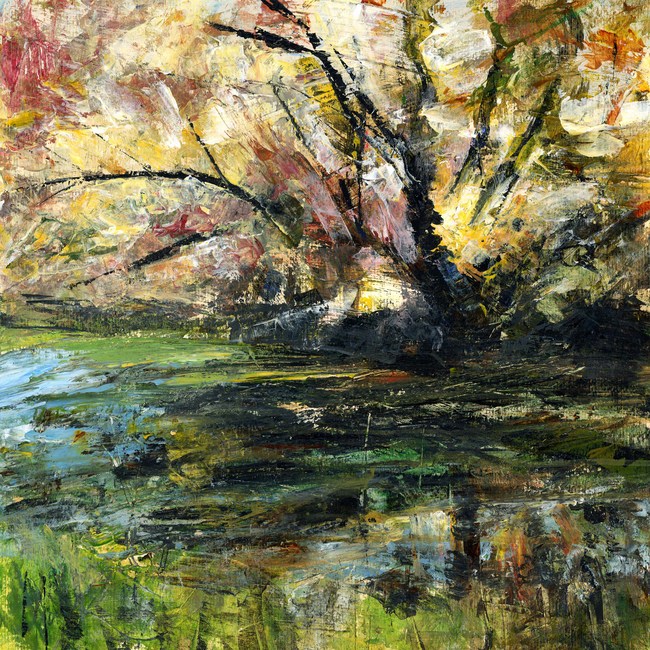
He says: “Most of my inspiration comes from the places I like to visit on a regular basis. The landscape around Blaenavon has been a favourite location of mine since my art foundation days at Newport College of Art. In my first couple of days at college we were sent off on a bus trip to introduce students from further afield to the area. The trip turned out to be a real eye opener for me. I had no idea this amazing location was so close to where I lived. The panoramic views over the Usk valley, the Sugar Loaf and Skirrid, to the north, the distant Black Mountains and to the south, the shimmering Severn making its way into the Bristol channel.
“It still has the same inspiring effect on me today as it did back then. Several paintings in the exhibition represent my response to the shifting light of the day, the transient skies and the changing colours of the seasons on this fascinating landscape. From the beautiful seascapes of west Wales to the rivers, canals and streams that are local to me. Water has long been a favourite subject of mine to paint. The canal has been a constant feature in my life and increasingly so in my work. Growing up I lived in a house that backed directly onto it, so I’ve spent many an hour on its banks gazing into the murky shallows. The paintings of the canal in the exhibition capture my response to the light on the trees along the canal bank and their reflections in the changing waters of early mornings and late evenings when the light is at its most interesting.”
The exhibition also features drawings by Harry Holland, many of which are featured in his new book Harry Holland: Drawings, published by Bird Eye Books, which is available to buy from the gallery. This unique volume collects examples of anatomical studies, still lifes, self-portraits, studies for later paintings and sketchbook pages from throughout his career, many of which are appearing in print and on display for the first time.
The collection has a foreword by the highly accredited theatre designer and artist John Macfarlane, as well as an introductory essay by the artist detailing his ideas on the theory, practice and uses of drawing today, providing a superb introduction to his work and artistic approach.
The exhibition runs from Friday, October 13 to Saturday, November 4.
There will be a Harry Holland book signing from 12-3pm on Saturday, October 14.
Artist Martin Llewellyn presents dramatic Welsh landscapes at Albany Gallery
Welsh artist Martin Llewellyn's greatly anticipated solo exhibition features a stunning collection of paintings from his favourite places in Wales.
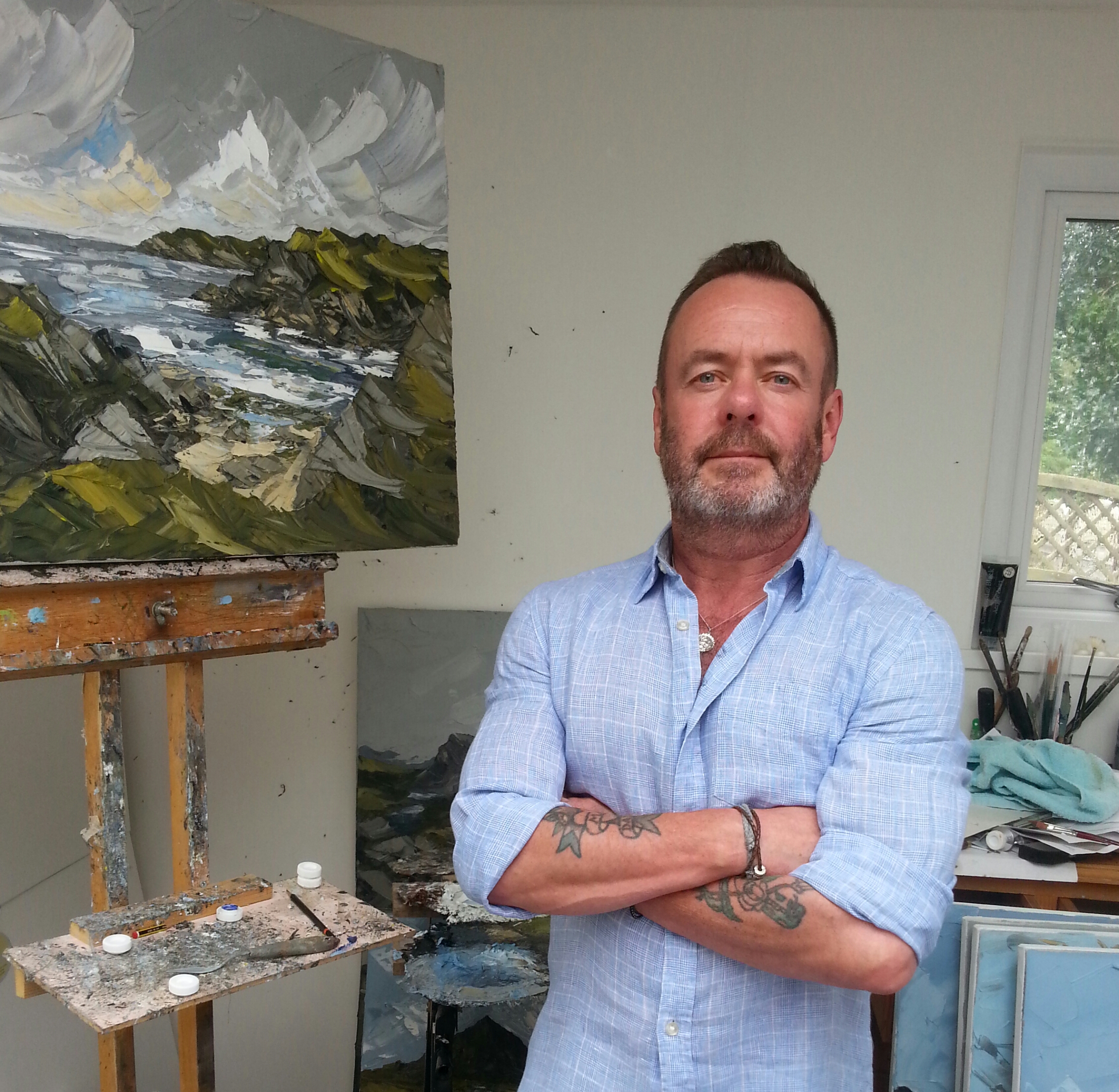
The Neath-based artist is well known for his distinct style, capturing the country’s moody, windswept landscape with his palette-knife paintings. His upcoming solo exhibition includes paintings of Pembrokeshire, Gower and North Wales.
Martin didn’t start painting professionally until 2012. Completely self-taught, he has quickly risen to be regarded as one of today’s leading Welsh palette knife painters. He began painting in watercolour painter but, inspired by the techniques of Sir Kyffin Williams, Charles Wyatt Warren and Gwilym Prichard, he soon discovered the dramatic possibilities of working in oils with a palette knife.
His richly textured oils in a muted palette beautifully capture the distinctive atmosphere of Wales, whether depicting the drama of Three Cliffs Bay, the shadows over Pen yr Ole Wen, Gwynedd or the waves beating against the cliffs at St Non’s, Pembrokeshire.
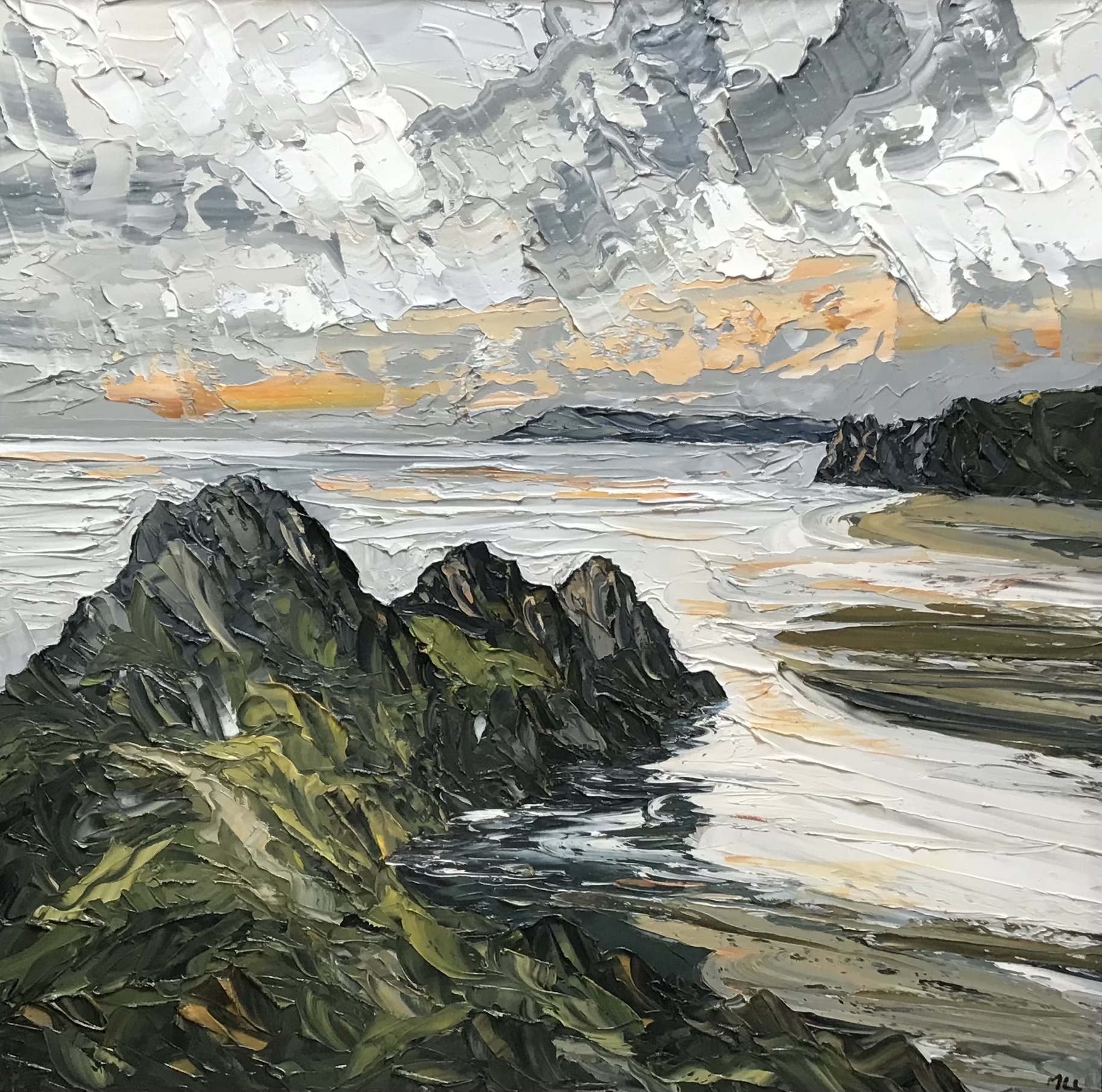
Martin has a deep affinity with the Welsh landscape, where the scenery can change dramatically in just a few hours. He paints with a rich array of deep greens and greys to portray a misty morning in the countryside of North Wales or adds a subtle yellow to capture the essence of the beautiful Fairy Glen in Betws-y-Coed.
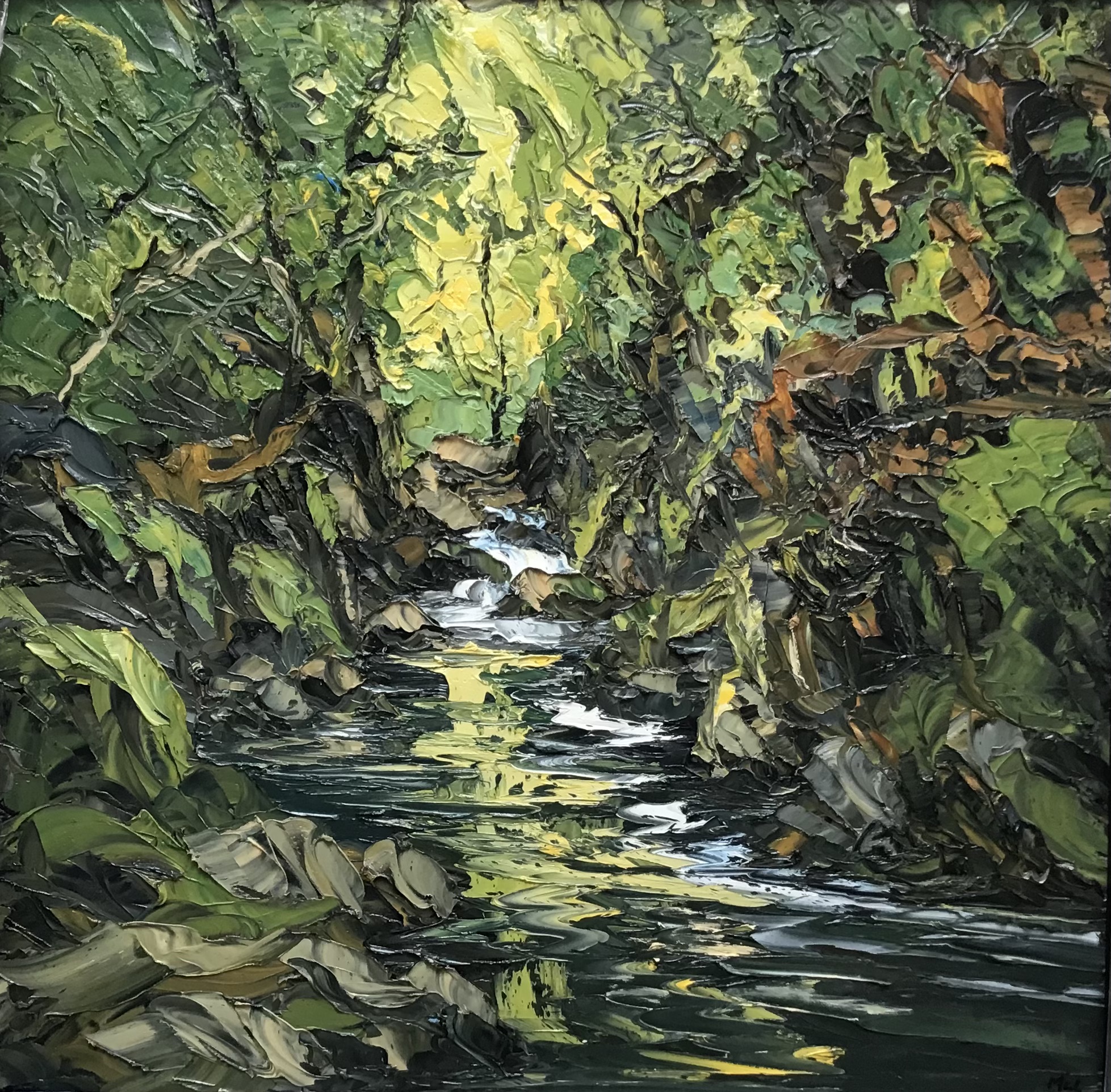
He says: “For this collection, I’ve taken inspiration from the dramatic coastline and landscapes of Wales and wanted to capture the mood and atmosphere into my paintings. I’ve visited all the places I paint. I normally sketch outside, then take the sketches to the studio to paint.
“I travel to North Wales regularly and, with Pembrokeshire and Gower basically on the doorstep, I tend to go there sketching as much as possible, whatever the weather.”
Martin is one of the gallery’s top selling artists, and has regular sell-out exhibitions in North Wales and London.
The exhibition runs from 15 September - 7 October.
Harry Holland's debut show at the Albany Gallery reflects the full scope of his talent, writes Jenny White
As always, there's a mythological bent to some of the work, from Fairy which features a model wearing a pair of wings, to Galatea, which depicts a woman emerging from a sculptor's block of marble.
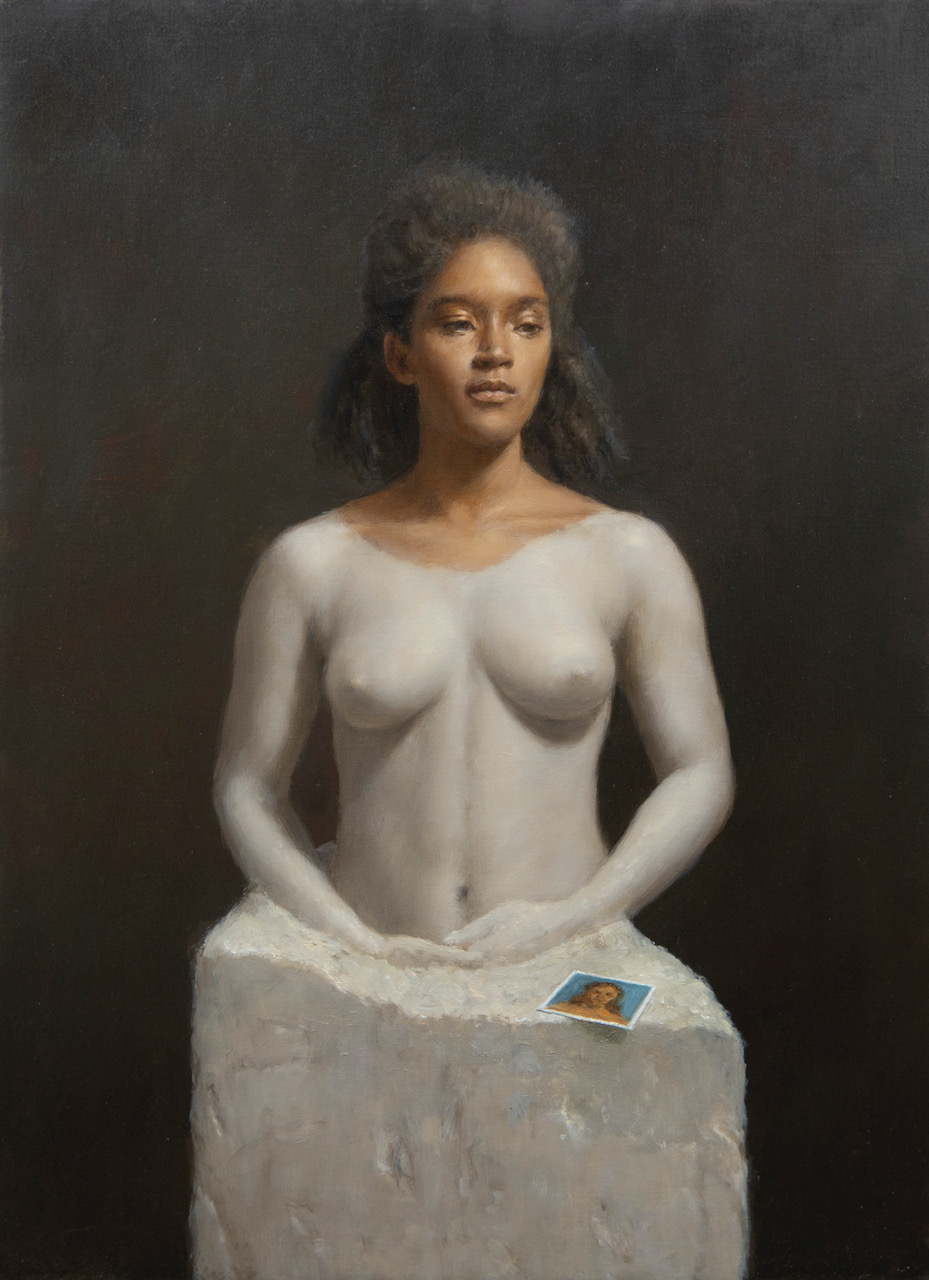
The Cardiff-based artist's fascination with the human form and the way in which the staging of a piece can dramatically alter a model's appearence is reflected in a series of three portraits of the same woman, each taking on a very different character as a result of changes to the lighting and to her clothing.
"These days I tend to be opportunistic about subjects," he says. "I just follow my interests rather than follow a particular sort of theme. These three portraits were really an investigation to find out how small changes can make a change in apparent character. In many ways, these three portraits could be different girls."
The show also includes several crisp, atmospheric still-life paintings, depicting a paintbrush, an iris and a mannequin that he sometimes uses in place of life models.
"Painting still life is different from painting a live model," he says. "With a live model you have somebody else in the room while you are working, there's a social element to what you are doing, whereas with still life they are not going to answer you back, they're not going to want to stop or listen to the radio and there's the advantage of complete concentration on the subject. Also, if you're drawing or painting from a live model, you're always conscious of the fact that they're going to see it and sometimes they can be quite critical. You don't get that with still life."
Having said that, he loves painting live models as much as ever, with results ranging from a wave to thoughtful portraits that are placed firmly in our time by the inclusion of mobile phones within the portrait.

"The iPhone adds a spot of reality, even if you've taken a traditional subject - a beautiful young woman - and turned into a fairy by adding wings, you've made it obvious that that's what you've done by putting in the iPhone. You're recognising mythmaking as an activity rather than as a real aspect of the world."
The exhibition continues until Saturday 22 July.
Artists Eloise Govier and Penelope Timmis produce a stunning display of colour at the Albany Gallery
The latest exhibition at the Albany Gallery plays host to Eloise Govier and Penelope Timmis in a vibrant and exuberant celebration of colour and imagination.

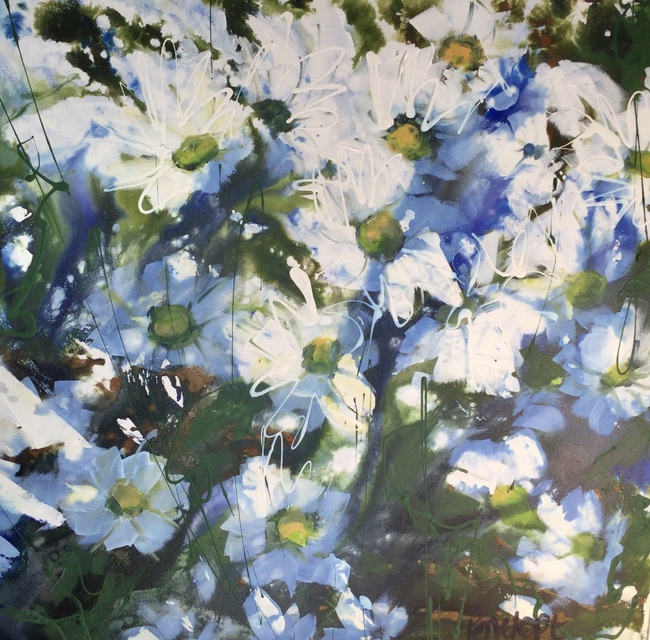
Both collections burst with life as a kaleidoscope of hues and striking compositions. Visitors will see a wonderful array of images including flowers and pretty cottages.
Eloise Govier has produced a new collection of works titled 'Gartref/At Home.’ The 20-piece collection is inspired by the work of the late John Knapp-Fisher, the hamlet of Abereiddi and the concept of home. The internationally-acclaimed artist, who was raised in Cenarth, Ceredigion, said the three elements were in her mind when she started to create the ‘Gartref’ collection.
She has very vivid memories of seeing postcards of Knapp-Fisher’s work at a young age, and feeling enchanted by his interpretation of the landscape. She saw an exhibition of his work last year, and wanted to follow in his footsteps to Abercastell, Mathry, Abereiddi and Llanwnda.

Eloise, who sketched and took photos and videos of the visit, says: “I am drawn to the high contrasts he created between the landscape and cottage or landscape and village. I think his work captures a very special atmosphere. It was very peaceful and quiet when I visited Abereiddi. The hamlet is right next to a pebble beach, and if you walk up over the hill past the cottage ruins you can see the Blue Lagoon which is a landscape feature connected to the slate quarrying activities of the late 19th and early 20th Century.
“At Abereiddi, when no one else is around, it feels possible to step back in time, the place is steeped in history. In my work, I respond to the buildings and landscape, looking at the world through my own lens, interpreting and expressing something new about what I see and feel.
“In this collection I created a number of studies on board and, in some cases, I’ve positioned the viewer quite close to the buildings. These studies often went on to inform the larger canvas paintings. Several paintings have an orange streak running from the house up through the sky, the line is intended to suggest a line of smoke from the chimneys, creating life in the home.
Penelope Timmis SWA lives in a converted church on the Welsh border in Shropshire and her collection includes a selection of stunning paintings that embody her distinctive style.
Colour, movement and life are the key elements of Penelope's work. A Member of The Society of Women Artists and Fellow of the Royal Birmingham Society of Artists, she says she is always searching for colour.
With a large following across the UK, Penelope’s contemporary and bold style is very recognisable. Well known for her colourful flower scenes, vibrant landscapes, rugged coastlines and birds, which range from comedic cockerels to quirky penguins. Penelope has won multiple awards and exhibits both nationally and internationally.
She is thrilled to be showing her work again at the Albany Gallery and says she continues to be inspired by the colours of the world around her.
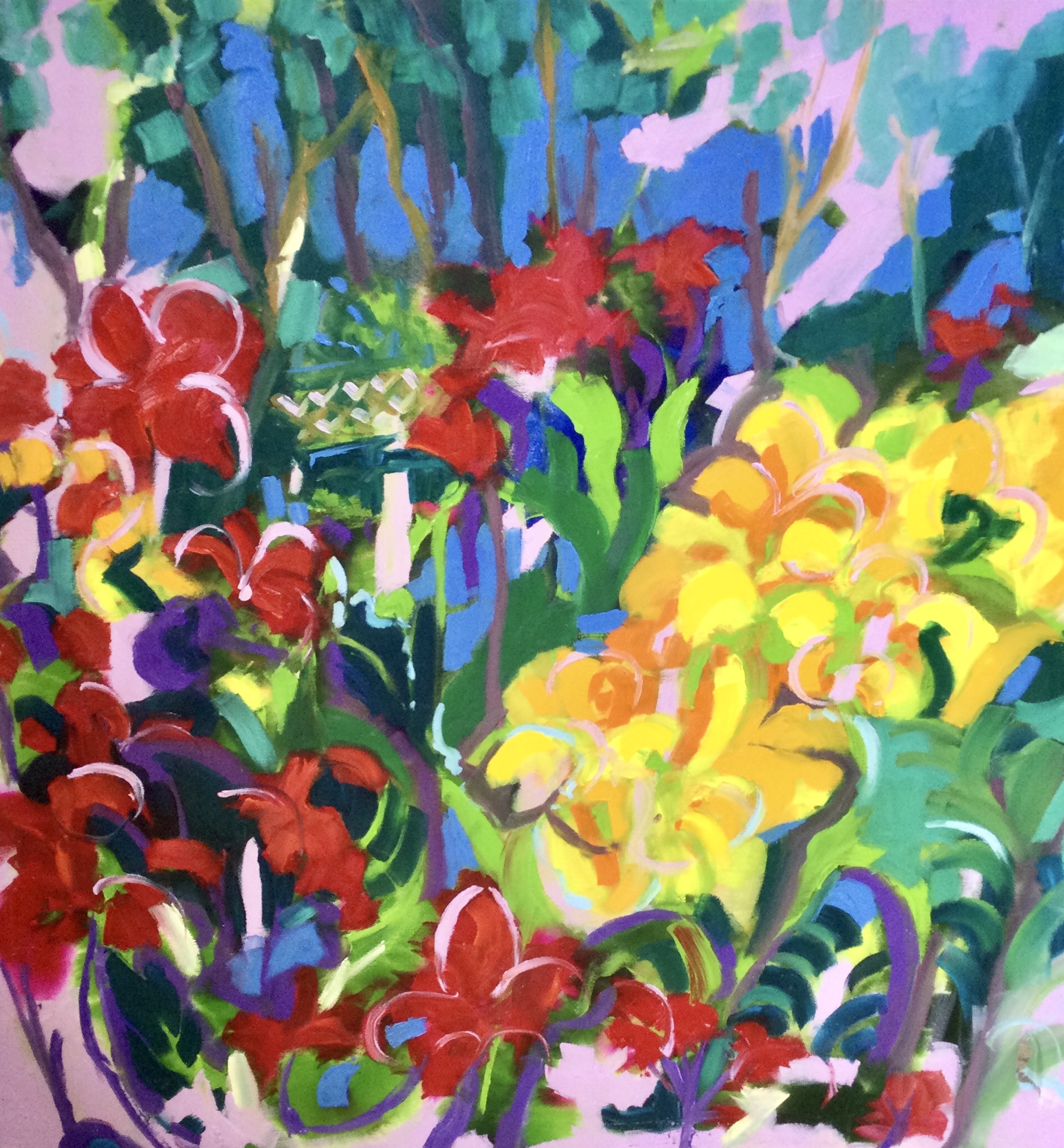
She says: “Whenever I look here, there and everywhere, I look for the same qualities for inspiration - a dash of colour, whether this is a beach, a field, a flowerbed, or even a bird. In the right light, there is colour in everything. I like to exploit this.
“Life is not static and I like to convey the constant movement of life all around us. Wherever I travel, my sketchbook is my constant companion. Following various trips this year I have a wonderful ‘encyclopaedia’ of sketches to work from. The bulk of this exhibition at the Albany are the fruits of this.
“I use a variety of mediums - watercolours, acrylic inks, acrylic paints, water soluble crayons and oils. My approach differs with each medium but I like to think that the freedom of my style is conveyed in all that I paint. I paint mainly from the many sketches that I have. Sketching for me is with a paintbrush and watercolour…… colour being my immediate response. I then play with this image to create my painting. I charge my canvas with many colours using ink on a fluid (water) surface. I will then build up my images using layers of ink and acrylic paint until I am satisfied. My signature is the final line of fluid acrylic.”
The exhibition runs from 30 June to 22 July.
New work from three talented and successful artists – Tom Hughes, Peter Kettle, Chris Prout
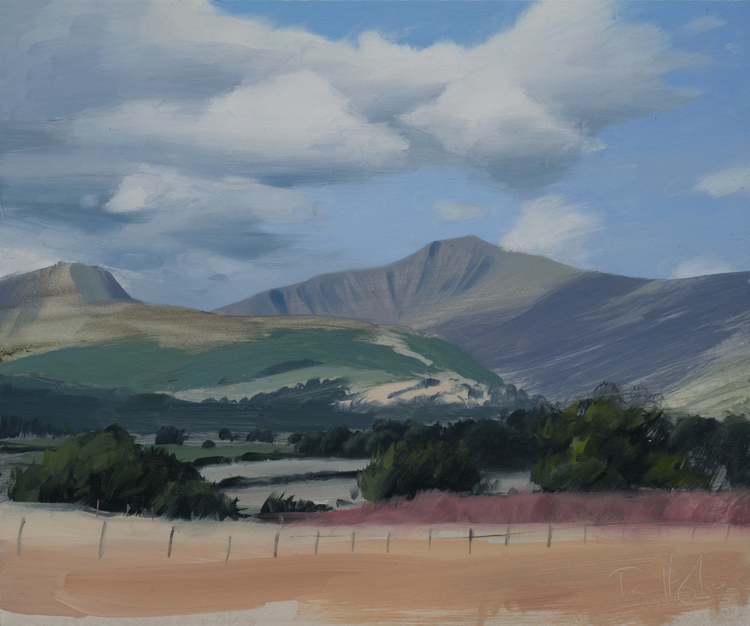
Bristol-based Tom Hughes surrounds himself in nature, light and weather in order to document an authentic human experience.
He says: “I have a deep affection for the Brecon Beacons and Black Mountains. I have been mountain biking in the area for 20 years and my parents live there, so it seemed a natural place to start painting.
“I love how low the clouds sit to the hills, creating an intimate connection to the weather and casting wonderful light effects. I aim to capture this in my work and communicate my love for the area.”
His collection also has images of famous London landmarks including Harrods, Trafalgar Square and Tower Bridge.

He adds: “I have been painting London on and off for 10 years and feel there is nowhere better to craft a street scene. Imposing, ornate architecture looms over busy streets and the traffic lights and car headlamps throw up all sorts of interesting contrasts that I love to render in oils.”
In his newest collection, British contemporary artist Peter Kettle FRSA RCA revisits and discovers the outstanding natural beauty of Wales and the Greek island of Kefalonia. A keen rambler, Peter brings together dramatic scenes from scaling Mt. Cadair Idris in Wales, chasing waterfalls across Powys and the Four Falls of Ystradfellte and afternoon walks in the olive groves of Kefalonia. Working primarily in oils and mixed media, these stunning landscapes and vistas are celebrated by Peter Kettle’s abstract/documentarian approach, visceral textures and evocative use of light on land and water.
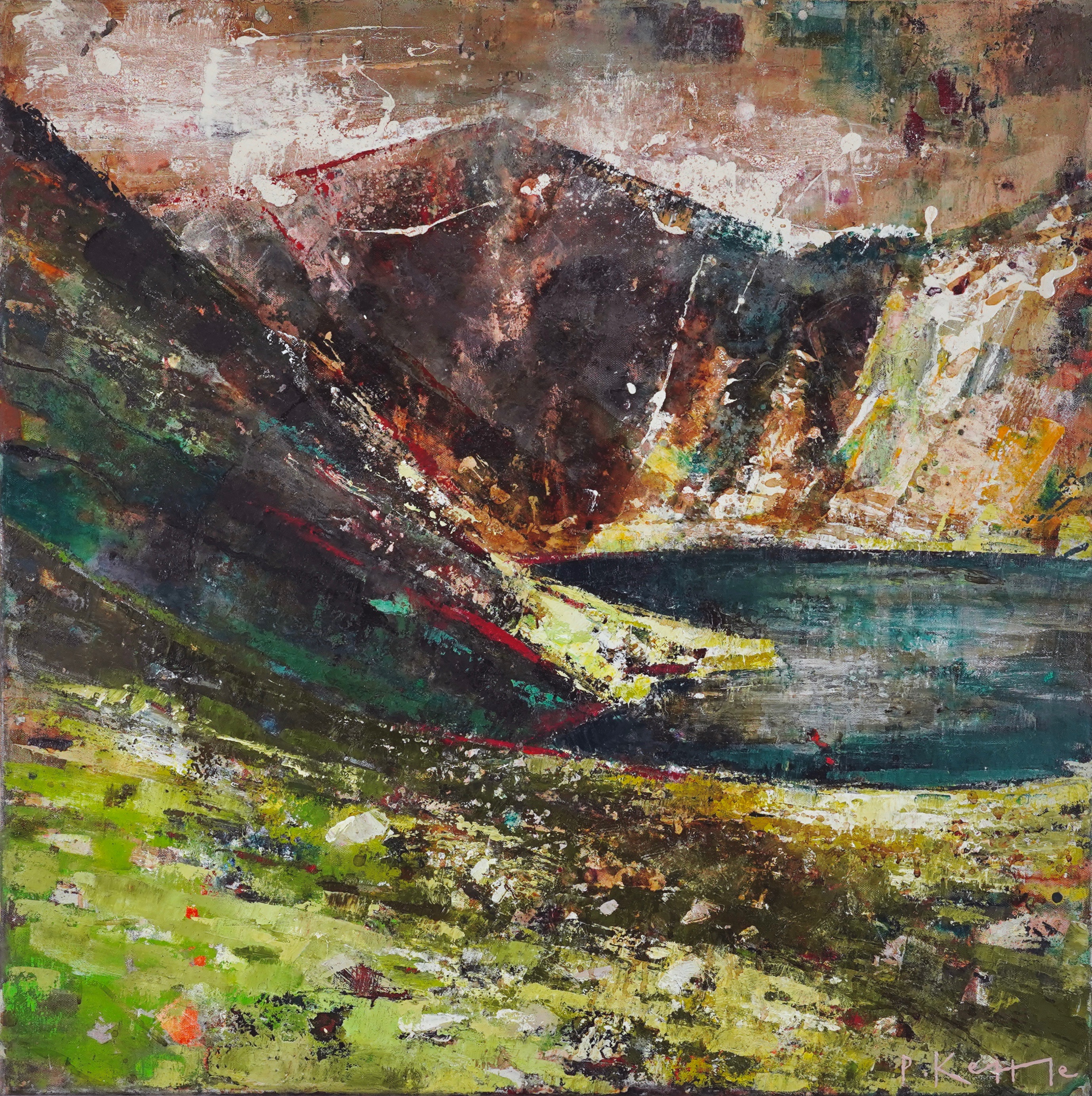
He says: “There are numerous legends about Cadair Idris. Some nearby lakes are supposed to be bottomless, and anyone who sleeps on its slopes alone will supposedly awaken either a madman or a poet. This tradition (of sleeping on the summit of the mountain) apparently stems from bardic traditions, where bards would sleep on the mountain in hope of inspiration. I have visited the top many times. It’s a tough hike to the top and I must have had a light afternoon doze at the summit as I took away a mountain of inspiration towards starting this new collection, and perhaps touch of madness to finish it.

“Growing up reading Captain Correlli's Mandolin by Louis Bernieres (the historical romance novel set in 1930's Kefalonia (Cephalonia) back-dropped by the Italian invasion of Kefalonia ) I’ve always wanted to experience the island that Bernieres waxed lyrically for its beauty. Today’s Kefalonia is more wanderlust travellers, sun-worshippers and a smattering of super yachts docked at a distance. It's quiet and slow, but perhaps it is a happiness shared that makes it a near perfect island to my wife and I, the countless exotic beaches each with their own identity, the passionate locals, or the dappled light in the olive groves along meandering coastal walks. This is also the home to Odysseus, the legendary but flawed king hailed in Homer's classic book 'The Odyssesy'. Having been lucky enough to visit Kefalonia twice now, the seed has taken root to come back again and again.”
Welsh-born Chris Prout, who now lives in Northamptonshire, is an established artist and well known for his dynamic interpretation of land, sea and architecture. His paintings are rich in colour and texture, and are impressionistic or semi-abstract in style. Inspired by nature, the countryside of Norfolk and Wales have formed a backdrop to his work.
He says: "The works I am exhibiting at the Albany Gallery are a brief amalgamation of places enjoyed and remembered. After a personal period of enforced time away from my easel I wanted paint some new works that were pleasing and optimistic to paint. This is a selection that very much helped me get back in the groove."
The exhibition runs from Friday, June 2 until Saturday, June 24.
Three artists whose work is inspired by nature and beauty are the latest trio to exhibit at Cardiff’s Albany Gallery.
Maggie Brown and Andrew Douglas-Forbes are inspired by the natural beauty of the countryside, with birds and flowers featuring in their collection, while Pete Monaghan highlights beauty in humble structures, which are often forgotten or overlooked.
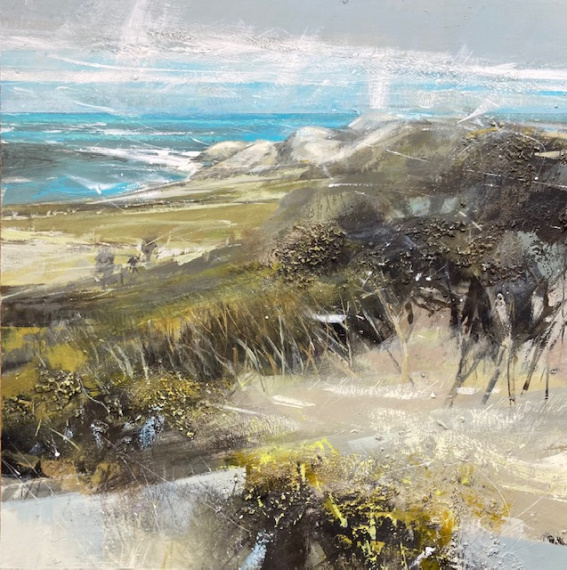
Maggie is an artist from Pembrokeshire who was born into a farming family. She says this gave her a solid foundation to combine and expand her love of art by painting the natural world and developing a lifelong interest in conservation. She explains: “I sketch and make notes intuitively outdoors. I feel this ‘imprints’ into my memory using all the senses. I am then able to develop paintings in the studio, using acrylics with sand, glue, shavings, mud, and more recently collage. This helps me to create texture and a ‘looseness’, to express the light and act to the emotional response; my hand, eye, and heart’s view on the land.
“This new exhibition has highlighted my need to share this feeling of being in the moment with our wonderful nature. I am forever hopeful that my paintings can evoke the same feeling in the onlooker; a sense of wellbeing, the importance of being aware, being in the moment and the joy and exhilaration that our beautiful countryside can offer, perhaps even help in its conservation.”
Her collection includes three paintings titled, ‘Nesting Places, Gorse for Whinchat, Linnet and Yellowhammer (now on the R.S.P.B. ’Red List’) which highlight the need to extend and leave large, scrubby areas of bramble, gorse, and grassland untouched. She added: “I want to spread the knowledge that hopefully, these areas are seen as a wonderful place where rare birds are nesting, in safety, not an unsightly mess to be eradicated.”
Andrew Douglas-Forbes, who is originally from Gower and now lives in Llandeilo, has produced a stunning collection of paintings based purely on snowdrops, something he has been keen to do for some time.
He says: “When I have a pending show I always wait for a catalyst or thread to appear before me. I have been wanting to do single themed groups for years now and finally felt the time was right to do an almost ‘installation ‘of pieces based purely on snowdrops. I have painted snowdrops for about 10 years now, always from the same abandoned cottage. The journey there is full of reverence, anticipation, hope, nostalgia.
“I primarily love the silver grey of the leaves as they foil the pure white - maybe tinged with yellowy green of the dangling flowers on their oh so slender stem. They seem to belong to nature; they speak of simplicity and obvious purity. They have a lonely quality as they preceded every other flower, but also are heralds of the year’s flowers to come.”
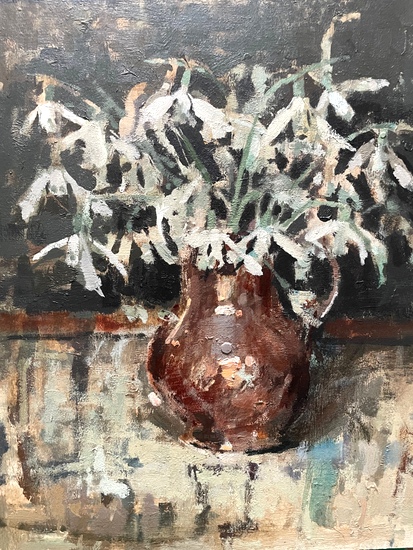
Though snowdrops are delicate flowers, Andrew says they possess a strength.
He adds: “Such a delicate subject but because I’ve chosen to exhibit them alone, a strength. I’m saying. ‘Look at these wonders, look how they illuminate the darkest of days, they speak of countryside. I therefore have great delight in finding my vessels and objects to place them in, so they speak as a whole. They belong to the objects they sit with and it’s about creating a new thing - a new painting that only existed in one’s head before.
“My colours are gentle and calm, highly suited to this subject. Hidden within are daring mixtures, the unconventional seeming very conventional. That is my secret weapon - white is never white, black certainly never near actual black and greens made from years and years of making odd mixtures. Nothing is as it seems - if you look hard into the painting there is rubbing, scratching, dragging, over and under paint, alchemy.
“I am delighted to be showing just snowdrops. It’s almost like a book of collected poems about winter, tranquillity and the odd teaspoon of sweetest melancholy winter days can conjure.”
Pete Monaghan, from Aberystwyth, finds his subjects in the wild, weather-beaten Celtic fringes. He’s always been fascinated with vernacular architecture, especially barns and farmsteads. He says: “I highlight beauty in humble structures, often forgotten or overlooked. In this body of work there’s an emphasis on upcycling and re-using. Some of the pieces have been quite heavily collaged with papers, maps, cardboard and takeaway coffee cups.

“There’s a nod to environmental concerns alongside highlighting the fragility of our (Welsh) vernacular architecture. Other pieces have been painted over many times, like “Mucky Sea”, sometimes the composition has been radically altered or the subject matter has changed completely in order to arrive at a resolved image.”
The exhibition runs from Thursday, 4 May until Saturday 27 May.
COAST - Seven artists celebrate the stunning coastline of Wales and Cornwall
A new exhibition at Cardiff’s Albany Gallery celebrates the beautiful coastlines of Wales and Cornwall.
The show features work by Peter Cronin, Dai David, Thomas Haskett, Sian McGill, Peter Morgan, Paul Sims and Rhona Tooze – each producing stunning images of Welsh and Cornish coastlines with a mixture of oils, acrylics and batik.
Paul Sims created most of his work for the exhibition during the pandemic. The former graphic designer used to work at BBC Wales before moving to London where he headed up a team responsible for the first introduction of online computer graphic systems. He was a senior executive and creative director, designing directing and supervising visual effects sequences for TV commercials, broadcast programmes and feature films. In 2003, he decided to relocate to Cornwall with his family and commenced on his lifelong ambition to become a successful artist.
He says: “The reference material is from the coast around my home in Lelant near St. Ives. The view across the bay is always an inspiration and changes every day. If I ever tire of that amazing vista on the approach to St. Ives it is time to give up! The ‘waves’ are from the rugged coastal area around St. Just in the far west. The rocks you see are named the Brisons, but know to the locals as Charles de Gaulle as the outline is very similar to his profile, head and stomach. The sea is again always changing depending on weather and wind direction. I try to paint the power, weight and movement of the waves. They are a joy to paint, usually taking a few weeks each and I hope people enjoy viewing the images.”
Rhona Tooze, based in Swansea, qualified as a specialist secondary art teacher from Swansea College of Art and is an expert in batik, the ancient art of wax resist dyeing. Her collection of works include many Welsh coastal locations, from Tenby, Rhosilli Beach, Three Cliffs Bay and the famous Langland huts.
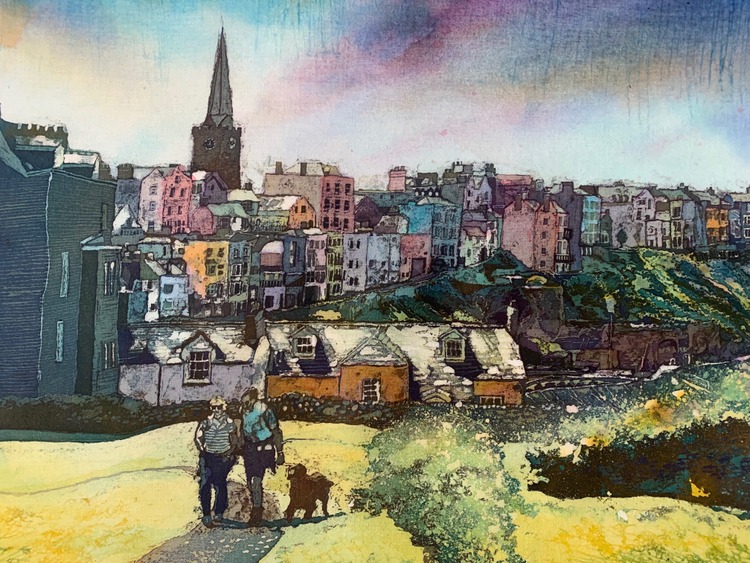
She says: “Batik is the art of wax-resist dyeing, mainly on cloth. It is very popular in Indonesia, where it is part of an ancient tradition. It is an exciting medium, but painting with hot wax is dangerous and I often burn myself. The thought process needed is similar to screen printing but only one image is produced. It is smelly and messy but the results are always a wonderful surprise.
She says: “I was thrilled to be asked to submit work for this show as the brief is perfect for my style and medium. I live on the edge of Gower and have always been inspired by the sea and surroundings. Portraying all these elements in batik, using hot wax and dye on fabric, is an absolute joy.”
The exhibition is a feast for coastal lovers. Peter Cronin’s work visits places including Lower Fishguard and Angle, Dai David’s oil paintings take us to Caswell Bay and Oxwich Bay and Peter Morgan has produced atmospheric coastal views from Marloes to Abereiddi.
There are also delightful scenes from Thomas Haskett at Nolton Haven and Dinas Head and Sian McGill’s acrylics, which feature Brandy Cove and Solva.
The exhibition runs from Thursday, April 6 until Saturday, April 29.
A trio of artists who draw inspiration from the streets, landscapes and characters around them
Alastair Elkes-Jones, Malcolm Murphy and David Williams will be showcasing a collection of paintings from Friday, March 10 until Saturday, April 1.
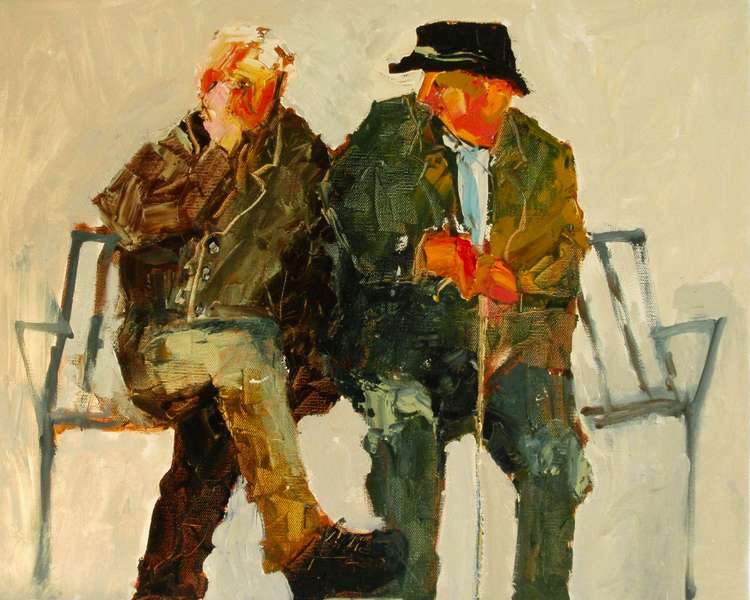
Alastair Elkes-Jones was born in Llangollen in 1942 and spent his childhood and formative years in the industrial and rural climate of North Wales. Since 1971 he has lived on the South Wales coast working at his studio in Mumbles.
He works primarily in oils, applying the medium with brush and palette knife, often onto canvas, building up the surface of the canvas with successive layers of paint. Finally, brushes are used to work both into wet paint and onto the drying layers of the under-painting to achieve a distinctive blend of texture and colour in the final work.
He says the subjects of his paintings for the Albany Gallery exhibition are the ‘spirits’ who helped him grow up artistically. However, the form the figures develop into on the canvas is entirely a work of imagination. They are not portraits, he says, but more an evocation of childhood. Memories of friends, family, neighbours, and strangers, forgotten yet so clearly remembered, who emerge out of the mysteries of forgotten time to once again say 'Hello.’
He says: “The people I paint are, to a greater or lesser degree, all known to me. They are the grown-up world of my childhood village - whilst sitting on our cottage front wall - the people I watched going about their lives, in conversation or off down the Co-op for something for tea.
“This also included a large farming community, sheep farmers in the hills surrounding Llangollen and Trevor, and the intrepid colliers returning from a shift at Bersham Colliery – faces black with ingrained coaldust before the installation of Pithead baths.”
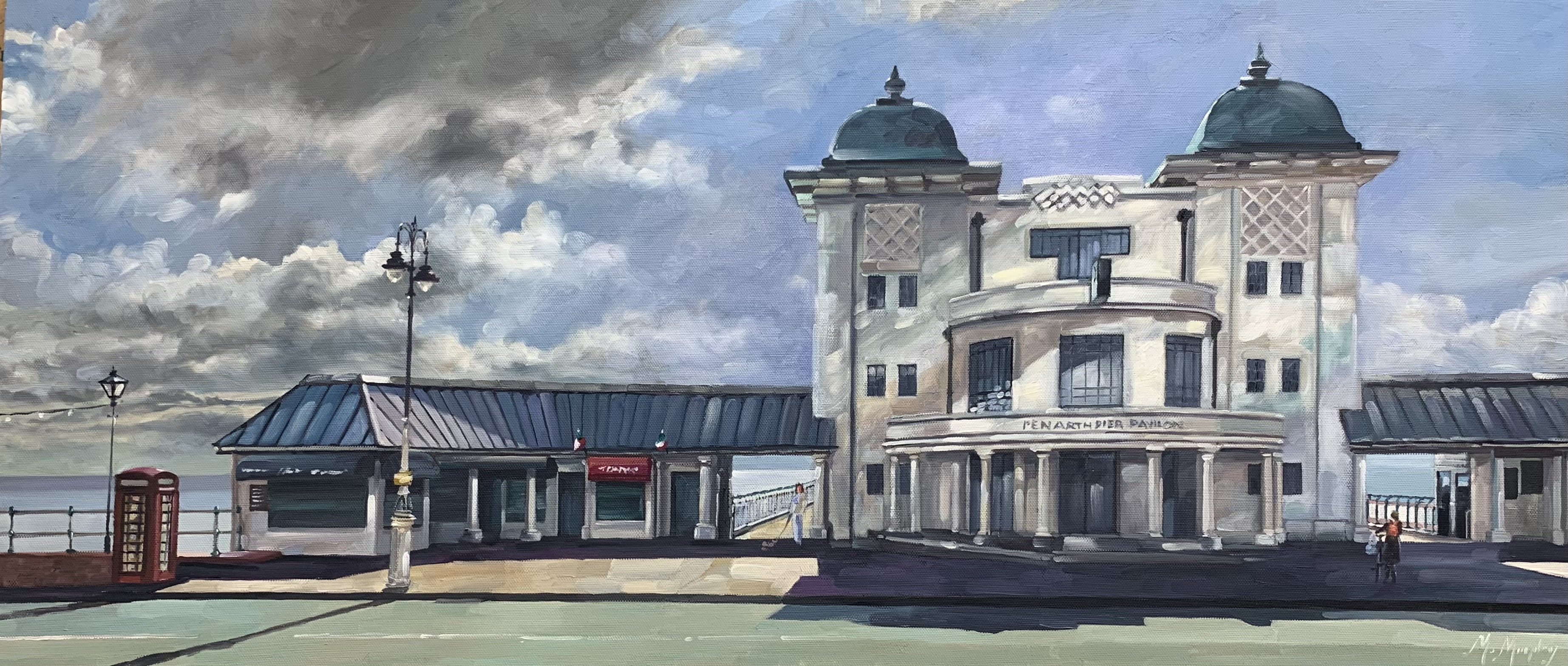
Malcolm Murphy has painted popular Cardiff places such as Wellfield Road, Penarth, Cardiff Castle and Park Place. His paintings use a range of mediums to portray expression and motion in the human form and from a diverse range of subjects, past and present, he attempts to discover in a descriptive environment the soul of his subjects and leave a sense of intrigue.
Malcolm, from Cardiff, is an award-winning artist and traditional craftsman who also carries out work as a professional fairground artist and regularly works on large scale murals for a variety of adventure parks across the UK. He is excited to be returning to the gallery that he used to visit as a youngster.
“Looking back 18 years ago I used to work in Lochaber Street Roath, just up the road from the Albany Gallery. I would always use the opportunity to call in and marvel at the glorious artwork they would have on show.
“A fond memory would be leaving work on a dark winter’s night and seeing the Albany Gallery still open with the lights glowing and lots of people as silhouettes looking at the artwork, I used to know it was a private opening night and wished it was myself taking part in the show. Little did I know 18 years later I would be included in the Gallery.
“I used to set off in the early days painting scenes of Cardiff and further afield with a view to hopefully having the paintings on display with such a prestigious Gallery.”
Work from secondary school PE teacher and artist David Williams is also on show. He draws inspiration for his paintings from the landscapes of South and West Wales, and predominately the Vale of Neath.
He says: “My current body of work are oil paintings of the Vale of Neath. The landscape is very familiar to me and I am able to draw on this in conveying my impressions of the fields, mountains, forests and skies of the area. I take my inspiration from the light and atmosphere of the place and the goal for each painting is to capture the initial visual impact it has had on me.
“The process starts with on-site sketches and photographs, followed by drawing the composition on canvas using brushes. The paint is applied by palette knife. Using the palette knife I am able to create a variety of layers of paint and textures which I find particularly satisfying.
“Once the composition and first layers of paint have been applied the finished painting is completed quite quickly. I prefer to finish a painting in one sitting if it is a small piece, or work in two-hour blocks to complete in a day. Rarely does a painting take me longer than two days to complete.”
Shining the spotlight on North Wales
Our latest exhibition celebrates work from several North Wales artists as well as a collection of paintings from the late artist David Barnes. The show features paintings from Russ Chester, David Grosvenor, Diane Metcalfe, Rob Piercy and Siôn McIntyre.
Russ Chester studied Art and Photography at Newcastle Upon Tyne College of Art & Technology, before moving to Wales and he said his artwork shows off the beautiful landscape that he is proud to call home. He has lived in Tremadog, Gwynedd for the past 40 years.

He says: “When I received an invite to show my work as part of the exhibition, I knew straight away which paintings I wanted to submit. All of the works have been chosen to encompass not only the incredibly varied landscape Wales has to offer, but also the various colours and techniques I employ in my painting process.
“While I’m known for my depictions of the rugged mountains and scenery of Eryri (Snowdonia), I’d become intrigued to see if I could make the immediate foreground the focus of the painting. People presume my paintings are highly detailed; on closer inspection they discover that any imagined details suddenly dissolve into seemingly random textures and techniques, and I wondered if I could apply this process to the confusion of grasses and wild flowers carpeting our fields.
“People also quickly realise that I’m more than happy using palette knife, fingers or any other tools I have to hand, but they’re generally horrified to see the state of my paint brushes which I deliberately abuse to within an inch of their life.
“After working outdoors for over thirty years, I feel driven to describe the Wales I’ve encountered along the way; not only as a place of enormous astonishing beauty but also as a place of quiet change and human attachment.”
Rob Piercy has been painting professionally since the early eighties. He trained as an art teacher and taught until 1990 when he decided to take the brave move to give up his teaching role and concentrate solely on his painting.
Rob is an experienced mountaineer so it’s perhaps not a surprise that his favourite subject matter are the mountains, in particular his native Eryri (Snowdonia) and, like Russ, he says his paintings sum up the passion and love he has for nature.
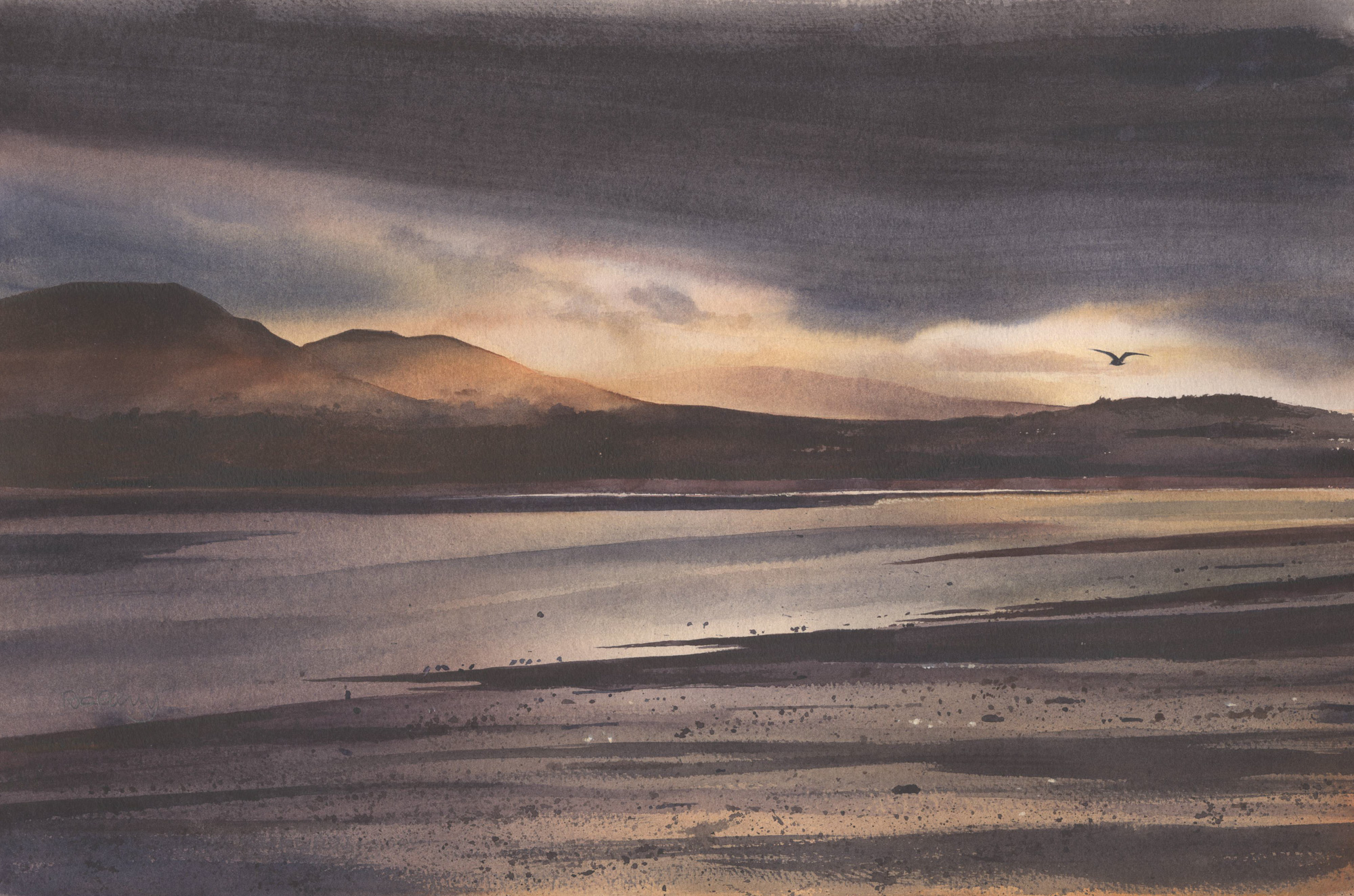
He says: “I love being amongst nature, the wilder the better, and I love painting nature, as it is. I am also transfixed by the surprise of the unexpected, like the sudden appearance of light on a mountainside or valley. Fact is, light is everything, it is the one ingredient that drives my art. It is a very simple yet powerful philosophy.
“I can truthfully say that every painting I have completed I have experienced being there, every sunset, every storm, every still quiet moment. Being amongst the transient nature of this satisfying yet often hostile environment is my inspiration.
“Recently I have been discovering some of the interesting nooks and crannies that are hidden away in old farm buildings and these subjects appeal to my love of drawing. A few of my pieces have been painted on the wonderful Khadi handmade paper from the foothills of the Himalaya. Wonderfully responsive to experiment. Watercolour needn’t be blatantly two dimensional it can be full of texture and colour.”
There are also paintings on show from artist David Barnes, a great friend of the Albany Gallery, who sadly passed away in May, 2021.
A former chartered accountant, he worked at the Open University and, although he enjoyed art at school and has been an art collector for many years, it wasn’t until he retired in 2006 that he began to paint seriously, progressing very quickly after spending many hours in the studio.
Elizabeth Campbell, current co-owner of the Albany Gallery, has fond memories of David.
She said: “In 2007 a new artist by the name of David Barnes brought in some work for appraisal by the then owner of the gallery, Mary Yapp. I had only been working at the gallery a short time and while he waited for Mary to arrive, we chatted and he told me that if Mary didn't approve of his work he would take it home and burn it! Mary told David that his work showed potential but suggested he should have some tuition and come back in a year's time.
“I knew that David would get rid of the paintings so I asked if I could buy one of them - David let me have it for £25, the cost of the frame. Little did I know then that I would buy the first of many David Barnes' paintings sold in the gallery. David took Mary's advice and he did return a year later and exhibited 30 paintings in the Christmas show in 2008, most
